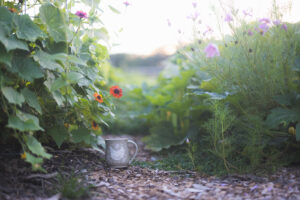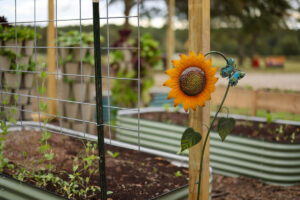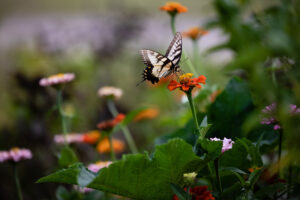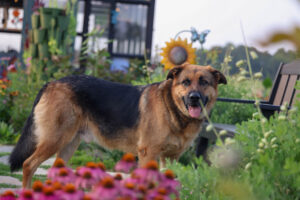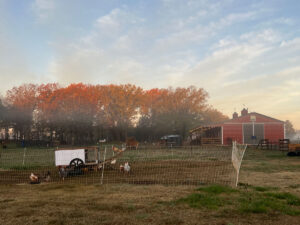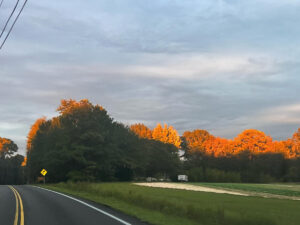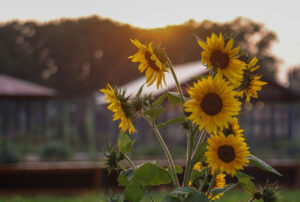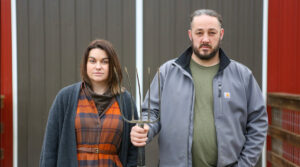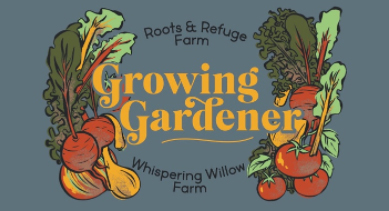I haven't always been an organic gardener, but having pests in the garden is a real pain when trying to grow food for your family. Learn about the organic garden pest control methods I now rely upon to keep my garden thriving and still safe to eat.
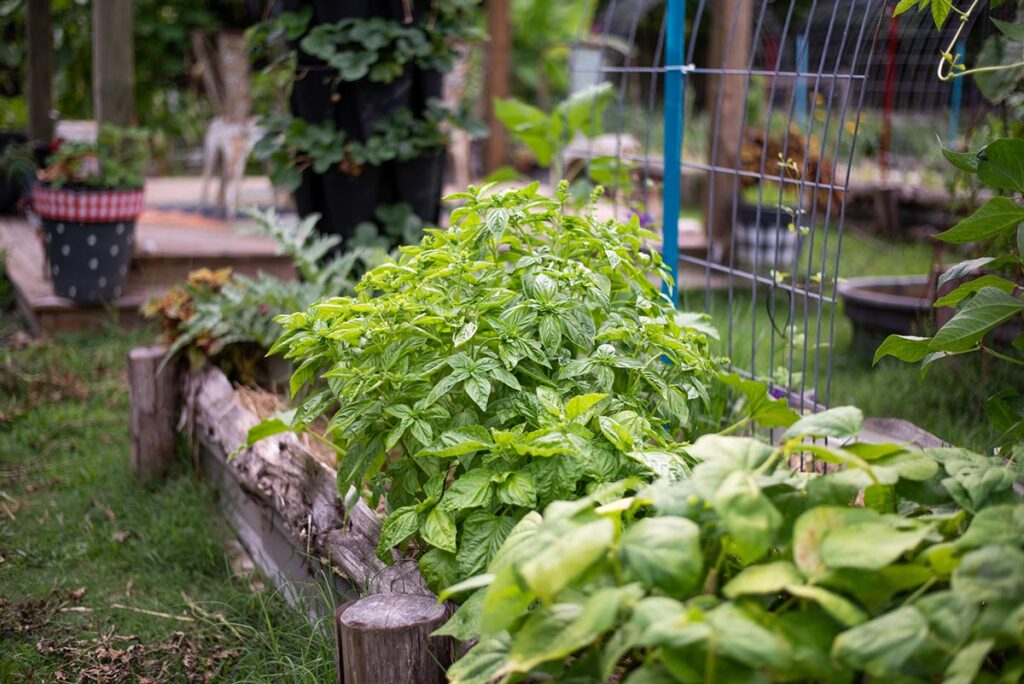
Why I Love Organic Garden Pest Control
I'm ashamed to say that there was a time in my life when my kids would be out in the garden and want to grab a quick snack and I'd jokingly say, “Wait, don't eat that! We have to wash the poison off it first!”
I always say you don't know what you don't know, and now that I know about the chemicals I was using to keep unwanted pests out of the garden I use these healthier organic methods.
Not only am I choosing better options, but I've also learned the best time of day to apply these methods to help keep the beneficial insects safe from harm.
It's wonderful to be able to have my kids out in the garden with me and we can all safely pluck a tomato off the vine and eat it without worry (or washing!).
In my opinion, growing a conventional garden, even using non-organic methods, is better than buying produce from the grocery store that's traveled miles to get there.
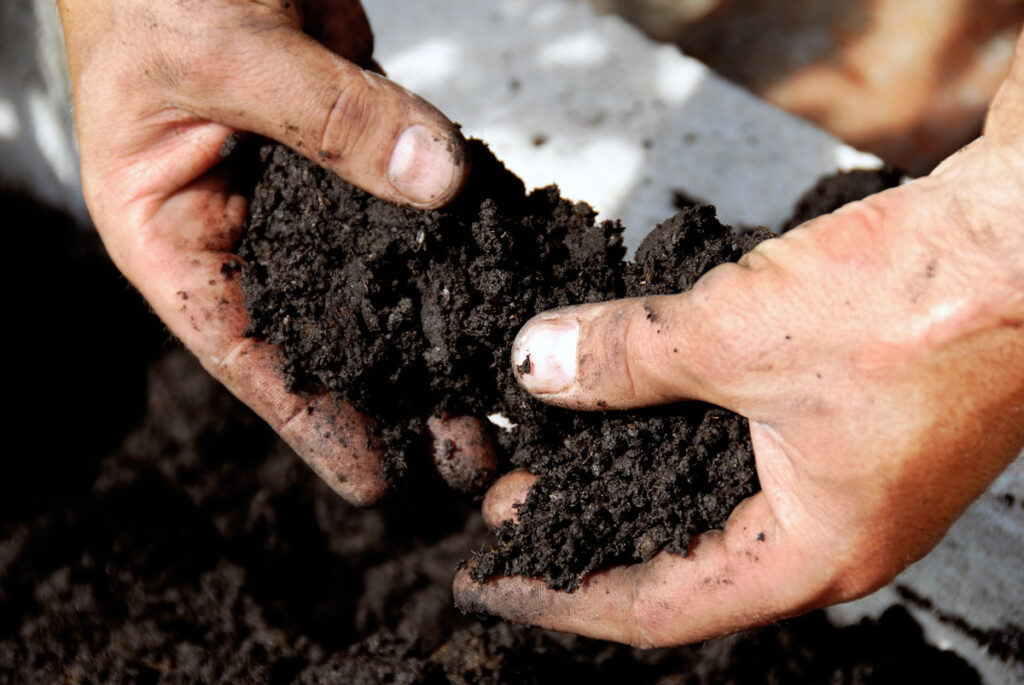
Building a Healthy Soil Ecosystem
If you're choosing to start using organic pest control methods in the garden, I recommend you also start using organic garden amendments.
The ultimate goal when gardening is to have healthy soil with a healthy ecosystem. Healthy soil grows healthy plants and I'm proof to say that within three years of utilizing these organic gardening methods you too can build up a healthy garden ecosystem.
What happens when you use non-organic soil amendments and fertilizers is that you're only feeding your plants instead of feeding your soil. When you're only feeding your plants, the biome in your soil eventually becomes compromised and you'll never have healthy plants without the use of those fertilizers.
Our goal is to build up the soil biome with microorganisms that will build rich soil, use mulch and organic matter like compost, and before you know it, you'll no longer need amendments because there is such life in that soil!
Remember, stressed and unhealthy plants are not going to thrive, and a pest infestation will decimate unhealthy plants much faster than healthy plants.
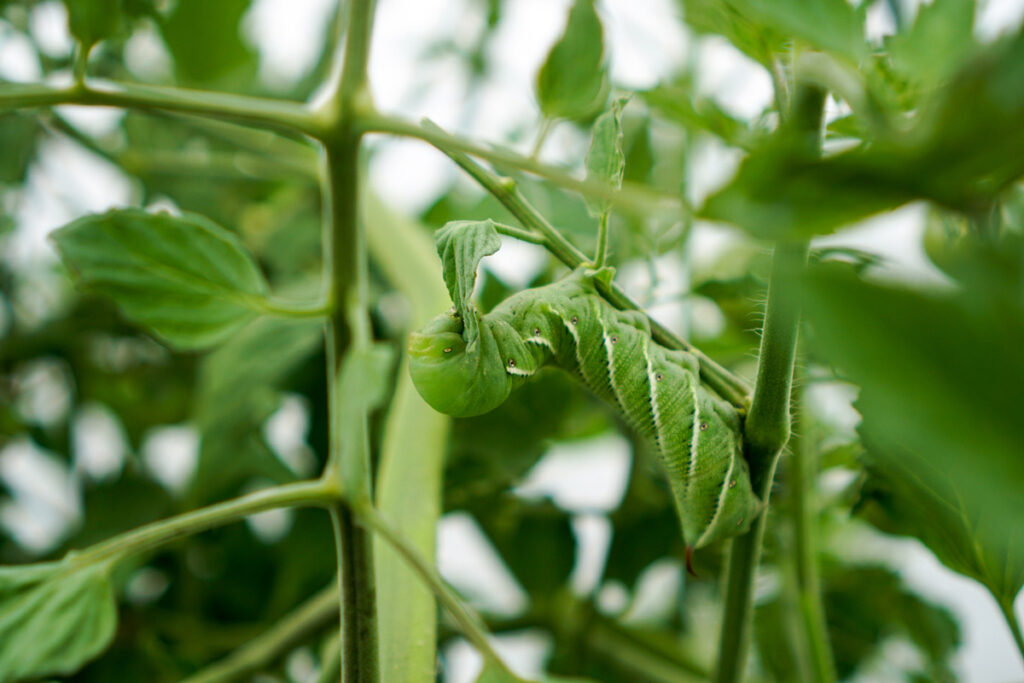
Switching from Non-Organic to Organic Gardening Methods
If you're wanting to make the switch from non-organic to organic gardening methods, I would say to expect about three years until your soil biome is healthy and strong.
Some people may think this is such a long time, but truly, it's not that long!
I'm currently building my first garden in South Carolina, but my garden in Arkansas had been organically gardened for many years. The last year I gardened in Arkansas, I didn't have to use any pest control at all.
People always look at me funny when they ask what my favorite organic garden pest control method is and I answer with “A Chair”.
But it's true! My favorite method is to just take a chair and sit in the garden with my cup of coffee in the morning. I will do more picking of insects off plants at this time than any other time of day. It's simply because I'm out there, enjoying my garden, instead of focusing on a task.
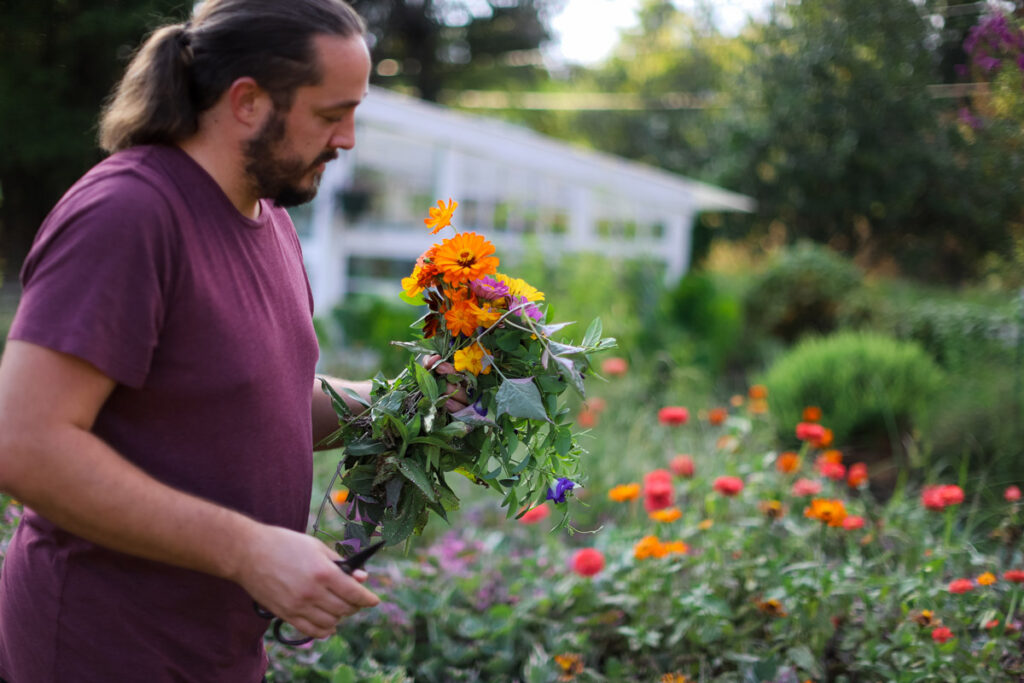
Flowers Are Your Friends
Flowers have a place in the home garden. They attract pollinators and bring life to a space. For me, they bring such joy and beauty and truly make my garden a space where I want to be.
If you don't want to give up space to something that doesn't have a use, plant things like chamomile and calendula that you can use medicinally. Plant basil and let it go to flower. Plant nasturtiums which are edible flowers.
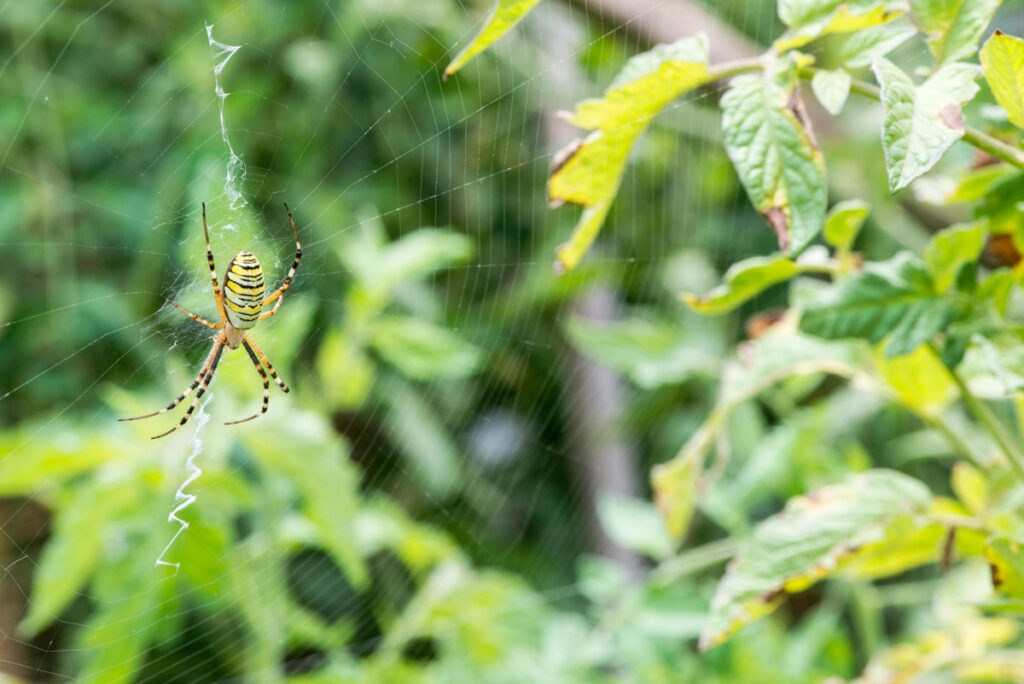
Good Pests vs. Bad Pests
Seeing garden spiders or wasps in the garden may be alarming, but it's important to understand the role these insects play in a healthy ecosystem.
Garden spiders will eat moths that get caught in their webs before they're able to lay eggs in your garden. Wasps actually eat certain pests. Ladybugs can decimate an aphid problem before it becomes a problem.
Over time you'll learn which insects are friends and which are foes. But my general rule of thumb when you see pests in the garden is to observe, watch, and determine that it's a problem before grabbing for the organic garden pest control.
I have come to know aphids, Japanese Beetles, and tomato hornworms as problem insects so if I see them I will react quickly. My first line of defense for these is actually not to treat them with organic garden pest control, but rather to handpick them.
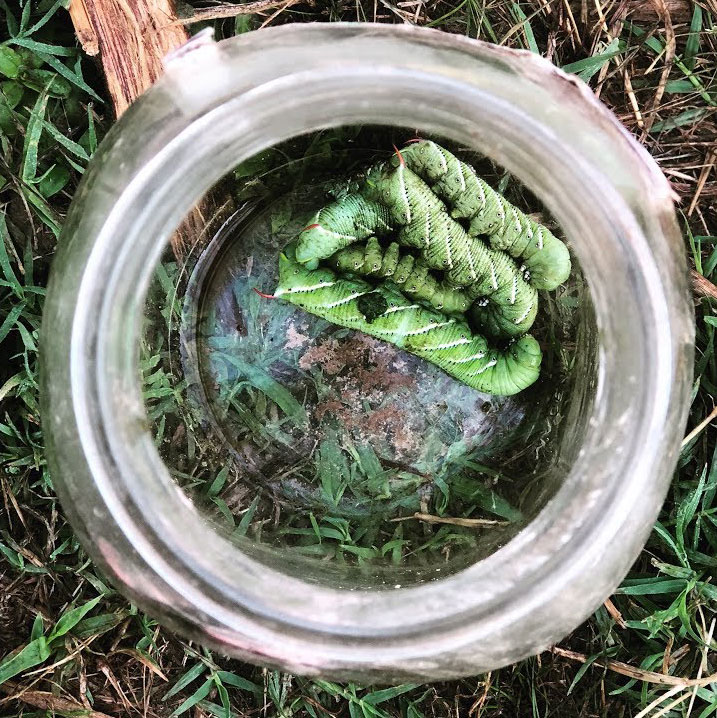
Hand Picking Garden Pests
Hand-picking garden pests can be a great line of defense. I like to go out late in the evening or early in the morning when the shadows aren't quite as harsh. I'll bring a jar with some soapy water inside and I'll pick off any pests and dunk them into the water.
Sometimes I don't add water and just put them into the jar, then take the jar over to the chickens. This works well, too!
If you don't like touching bugs with your hands, I have also heard some people using a hand vacuum and sucking up the insects into the hand vac, then emptying that into a bucket of soapy water, or feeding it to the chickens.
The Best Organic Garden Pest Control Methods
Something I have noticed since switching to only using organic garden pest control methods is that in the following years, the battle isn't as hard. It may not be completely gone, but it gets better year over year until, as I mentioned before, I no longer need these methods on a regular basis.
When looking for organic garden pest control methods, always make sure it's marked USDA Organic, says for organic gardening, or is OMRI certified.
Because most of these pest control methods are effective when the insect actually eats it, I like to try and avoid applying them to any flowers or places that the beneficial insects might come in contact with it and only treat the affected leaves or foliage.
Spinosad
If you were only going to buy one pest control method, this would be my recommendation.
Spinosad is actually made from a soil bacterium that can be toxic to insects but isn't toxic to mammals. It's gathered in the fermentation of the soil and the bacterium is called Saccharopolyspora spinosa.
The brand I use is called Captain Jack's Deadbug Spinosad.
Spinosad affects the nervous system of any insects that touch it or eat it, causing them to eventually die.
This is mainly effective on caterpillars or anything in the larva stage, thrips, beetles, and leaf miners. It works best when consumed by the insects, but can have some effect when touched by the insect.
Because this is a bacteria, the water that you mix this up with matters. If you have hard water, it can tend to be very alkaline and can actually kill the bacteria deeming it ineffective. If you're unsure of the alkalinity of your water, just use store-bought water to get the best results.
Bacillus thuringiensis or B.T.
B.T. is similar to Spinosad and is also a species of bacteria that lives in the soil.
B.T. is controversial because it has been used in labs and bred into some GMO crops to be naturally more resistant to pests. Some people say not to use B.T. because it's GMO, but that's actually misinformation.
Though there are GMO crops that have been bred to include it, B.T. itself is not actually GMO.
It's non-toxic to humans and animals because we don't activate the proteins that cause it to kill insects.
B.T. is solely effective on insects when they eat it and is effective on insects in the larva stage.
Just like Spinoside, B.T. is a bacteria so the water that you mix this up with matters. See the note on what kind of water to use above!
I have used B.T. the most when I start seeing cutworm damage on my brassicas. This is one I will actually spray on the crops in the morning because the honeybees will not be eating the brassicas.
Do be sure you don't spray this on things like parsley or dill because these are host plants for butterfly larva.
This is the B.T. brand that I have.
Diatomaceous Earth
Diatomaceous earth is very commonly recommended for organic gardening (also known as DE). You can buy DE more affordably at feed stores in large 50-pound bags.
The way I use DE is to take inexpensive dollar store pantyhose, add some DE and tie it up then sprinkle it where needed.
Do be sure not to inhale it as it's very abrasive to the lungs.
DE are actually fossilized remains of a hard-shelled organism called diatoms.
It kills hard-shelled insects by cutting through the exoskeleton of the insect and drying them out. It can work on soft-bodied insects but is most effective on hard-shelled insects.
If it rains, DE gets washed away and is no longer effective and must be reapplied. Be sure to check the forecast ahead of time!
I like to use DE for an active infestation of beetles (flea-beetles, squash bugs, Japanese beetles, etc.). After hand-picking off every bug I can see, I then dust the plant with DE.
Here's a bag of DE from Amazon, but as I mentioned above, the best price will be at your local feed store.
Neem Oil
Need oil is an often suggested option in the organic gardening world. Do be sure you're getting 100% cold-pressed neem oil. There are a lot of products out there that aren't 100% and you'll be wasting your money.
Neem oil works as a repellant and a suppressant. It's used to deter bugs from eating your plants at all, not to actually kill the bugs themselves. It is true that if a bug eats neem oil that the bug will eventually die. From what I understand it suppresses the bug's appetite (and suppresses their ability to breed) and they eventually die.
Neem oil is not my go-to method of organic garden pest control simply because I feel the other methods work better. Although, Neem oil is my method of choice to get rid of flea beetles.
When diluting need oil with water, I recommend adding a squirt of castile oil because it will help the neem oil and water mix together better.
Also, only spray neem oil in the cool of the day (either early morning or late afternoon) to avoid burning your plants.
You can find 100% cold-pressed neem oil here.
Pyrethrin or Pyrethrum
Pyrethrin or Pyrethrum is derived from a compound in chrysanthemum flowers. When applied to the insects it damages their nervous system and kills them almost immediately.
This is non-discriminatory and will kill the beneficial insects as well, so try to avoid flowers and only apply in the evening when the honeybees won't be out.
Pyrethrin dissipates in about two days, so you will need to reapply if the issue isn't controlled with one treatment.
If the issue is really bad I generally will reapply for a handful of days to interrupt the breeding cycle and knock back the population.
This is the brand of Pyrethrin I have.
Do watch out for the product called permethrin, that's the synthetic version of pyrethrin and will not break down for up to 90 days. I don't recommend using this as it will kill everything in your soil for 90 days.
Soap
You can buy insecticidal soaps at the store, but by simply adding a squirt of soap to the bottle when diluting the treatments mentioned above, you can increase the odds of effectively treating the pests.
Soap alone can kill insects, but you have to actually come into contact with the insect itself. Simply spraying the foliage will not kill the insects.
I don't recommend using antibacterial soap such as Dawn dish soap because I don't want that washing down into my soil, potentially killing beneficial microbes living there. I prefer to use Dr. Bronners castile soap in peppermint (which actually includes peppermint essential oil, another pest deterrent).
Essential Oils
There haven't been a ton of studies done on the effective use of essential oils on pests. I know there are many essential oils that are known to repel insects such as peppermint, rosemary, citronella, and geranium. Oregano is also known to repel insects, but that's a very strong medicinal oil that I don't want to use unless I'm using it for medicinal purposes.
I simply add a few drops of one of these essential oils into the pest control mixture and spray.
Mighty Mint Spray
There are options for store-bought mixtures that include essential oils. However, these will cost you more money than simply mixing up your own at home.
I do know there are some people who simply want the convenience of treatments already mixed up and some people who will want the more affordable options. I like to share both, so this Mighty Mint Spray is a good option.
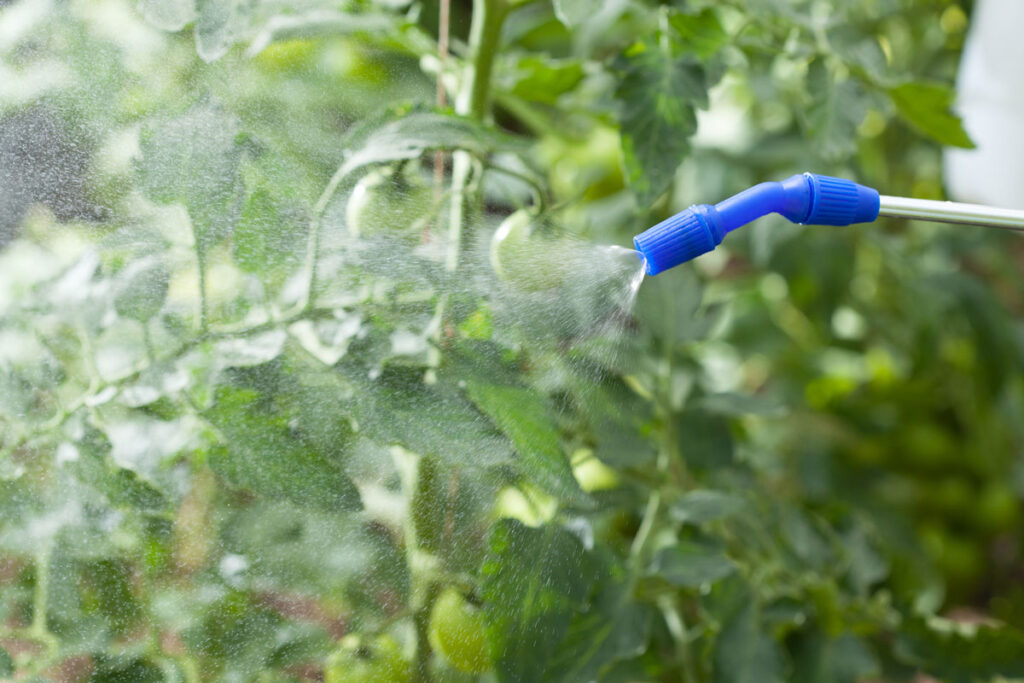
Tips for Using Organic Pest Control
There are some variances in using organic pest control methods vs. their non-organic counterparts. For instance, the time of day, whether there's rain in the forecast, and how you broadcast the treatments may differ.
Time of Day
The time of day is important when using these pest control methods. You don't want to add neem oil to your plants in the heat of the day. I compare it to putting tanning oil on when you're at the beach. The neem oil will cause your plants to burn.
The best time of day to use these methods is in the late afternoon or early evening after all the pollinators have stopped flying around.
These pest control methods don't discriminate and can't tell the difference between a honeybee and an aphid.
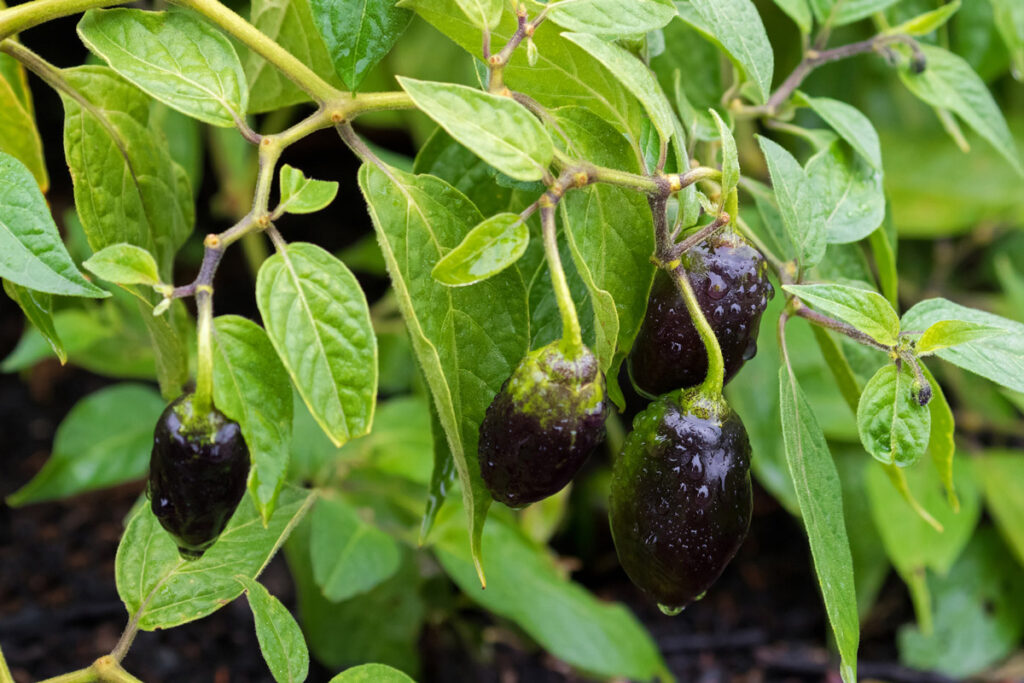
Watch the Weather
Because these are organic pest control methods, you will need to reapply them after the rain or overhead watering. Some non-organic/synthetic methods will stay in your garden for upwards of 90 days, but these won't.
I always like to take a look at the forecast before treating my plants because, if I see there's rain in the forecast, I may wait a day or two to save myself time and energy.
Spot Treat Only
I never broadcast these pest control methods over everything. Only spot treat as you see the pest issues. I don't want to risk hurting any of the beneficial insects that are in my soil or pollinating my plants.
Buy Concentrate
To save yourself some money, always buy the concentrate version when possible. You can buy pre-diluted mixes and you'll end up paying 3x as much overall (sometimes even more), plus the concentrates last for years on the shelf. So at the end of the year, just put them in your garden shed and you're good to go for next year.
Get a Sprayer
Save your hands and speed up the process by buying one of those 1-gallon hand pump sprayers. You can certainly mix this up in a smaller spray bottle, but trust me when I say the pump sprayers will keep your hands from cramping!
Always mix up your treatments per the instructions on the bottles!
More Gardening Posts You May Enjoy
- Get Rid of Tomato Horn Worms Naturally
- How To Plant Tomatoes the Best Way (Tips for Success)
- Growing Determinate and Indeterminate Tomatoes
- How to Build a Garden Arch Trellis or Garden Arbor (for $30!)
- Build a Raised Garden Bed (On a Budget)
- How to Grow Salad Greens in the Winter

